#National Wildlife Federation
Explore tagged Tumblr posts
Text
https://www.nwf.org/Educational-Resources/Wildlife-Guide/Invertebrates/Horseshoe-Crab
Important facts about horseshoe crabs!!!
#horseshoe crab#marine biology#zoology#marine life#sea creatures#sea critters#marine ecology#invertebrates#national wildlife federation
2 notes
·
View notes
Text
youtube
Creating habitats that provide NYC's bees, butterflies, and birds with much-needed nourishment is is an important function of our gardens. How can these gardens also function as classrooms? The National Wildlife Federation helps create Schoolyard and Community Habitat gardens all over NYC. During this webinar, they teach you how to to create a habitat garden that cultivates curiosity, and offers an array of rich educational experiences.
Facilitated by Sarah Ward, National Wildlife Federation
Moderated by Mara Gittleman, NYC Parks GreenThumb
This webinar was part of 2021 Earth Week at GreenThumb, where we learned about and uplifted the ecological benefits of native plants in community gardens.
#NYC Parks GreenThumb#solarpunk#gardening#garden#habits#new york#new york city#USA#bees#butterflies#birds#plants#webinar#National Wildlife Federation#Schoolyard and Community Habitat gardens#habitat garden#Sarah Ward#Mara Gittleman#Youtube
12 notes
·
View notes
Text

Young Nature Photographers | Second Place
A day-old sandhill crane chick peeks out from its parent’s protective feathers at a park in Michigan known for its abundance of waterfowl. John Fortener, now 16, had gone to the park on a rainy April morning knowing that eggs from the area’s nesting sandhill cranes would be ready to hatch.
Using a zoom from a safe distance, he was delighted to see the tiny head pop in and out of this feathery tent. His advice to other young photographers? “Get outside as much as possible and just watch.”
#sandhill crane#sandhill crane chick#wildlife#nature#nature photography#photo contest#crane chick#baby sandhill crane#National Wildlife Federation
4 notes
·
View notes
Text
they were ruthless

LMAO THEY WERE RUTHLESS
12K notes
·
View notes
Text

1 note
·
View note
Text

1 note
·
View note
Photo

Denver Landscape Pathway This picture shows a large, stone garden path that receives full sun in the southwest during the summer.
#national wildlife federation#ourdoor living environments#gardening and irrigation#mimi elmore#garden water features
0 notes
Text
Celebrate NWF's Garden for Wildlife™ 50th Anniversary!
I’ve always liked nature and wildlife but my interest really took off back in the early 1970s. My mother came home from a trip to Oklahoma and told me that my Aunt Fran (aka Miss Fran from Story Land if you grew up out there) had her yard certified as a National Wildlife Federation (NWF) Backyard Wildlife Habitat . Knowing my Aunt Fran (sha has always been one of my idols), she may have been one…

View On WordPress
0 notes
Text
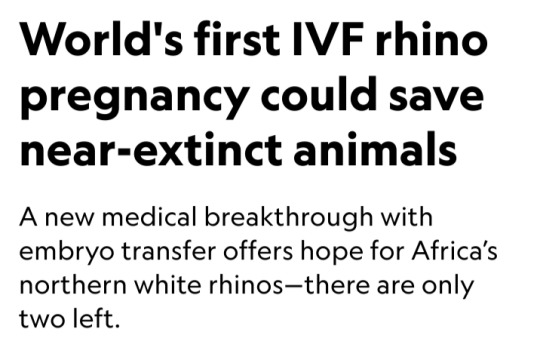
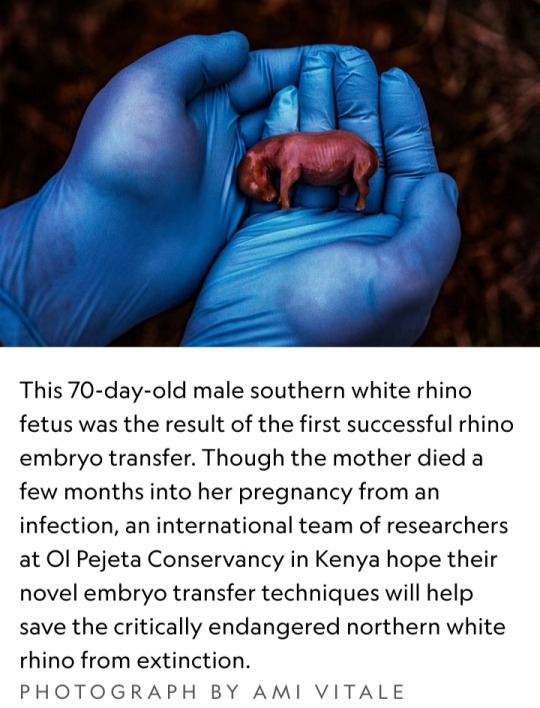
By Dina Fine Maron
January 24, 2024
Scientists have cleared a significant hurdle in the years-long effort to save Africa’s northern white rhinoceros from extinction with the first-ever rhino pregnancy using in vitro fertilization.
The lab-assisted pregnancy, which researchers will announce today, involved implanting a southern white rhino embryo in a surrogate mother named Curra.
The advance provides the essential “proof of concept” that this strategy could help other rhinos, says Jan Stejskal of the BioRescue project, the international group of scientists leading this research.
Curra died just a couple months into her 16-month pregnancy from an unrelated bacterial infection, Stejskal says.
However, the successful embryo transfer and early stages of pregnancy pave the way for next applying the technique to the critically endangered northern white rhino.
The process was documented exclusively by National Geographic for an upcoming Explorer special currently slated to air in 2025 on Nat Geo and Disney+.
BioRescue expects to soon implant a northern white rhino embryo into a southern white rhino surrogate mother.
The two subspecies are similar enough, according to the researchers, that the embryo will be likely to develop.
Eventually, this approach may also help other critically endangered rhinos, including the Asian Javan rhinoceros and the Sumatran rhinoceros, which each now number under 100 individuals, Stejskal says.
But the northern white rhino’s current situation is the most pressing by far.
There are no males left, and the only two remaining animals are both elderly females that live under armed guard on a reserve in a 700-acre enclosure in Kenya called Ol Pejeta Conservancy.
The boxy-jawed animals once roamed across central Africa, but in recent decades, their numbers have plummeted due to the overwhelming international demand for their horn, a substance used for unproved medicinal applications and carvings.
Made from the same substance as fingernails, rhino horn is in demand from all species, yet the northern white rhino has been particularly hard-hit.
"These rhinos look prehistoric, and they had survived for millions of years, but they couldn’t survive us,” says Ami Vitale, a National Geographic Explorer and photographer who has been documenting scientists’ efforts to help the animals since 2009.
“If there is some hope of recovery within the northern white rhino gene pool — even though it’s a substantially smaller sample of what there was — we haven’t lost them,” says conservation ecologist David Balfour, who chairs the International Union for the Conservation of Nature’s African rhino specialist group.
Blueprints for rhino babies

To stave off the animal’s disappearance, BioRescue has used preserved sperm from northern white rhinos and eggs removed from the younger of the two remaining females.
So far, they’ve created about 30 preserved embryos, says Thomas Hildebrandt, the head scientist of BioRescue and an expert in wildlife reproduction based at the Leibniz-Institute of Zoo and Wildlife Research in Berlin.
Eventually, the team plans to reintroduce northern white rhinos into the wild within their range countries.
“That’d be fantastic, but really, really far from now—decades from now,” says Stejskal.
Worldwide, there are five species of rhinoceros, and many are in trouble.
Across all of Africa, there are now only about 23,000 of the animals, and almost 17,000 of them are southern whites.
Then there are more than 6,000 black rhinos, which are slightly smaller animals whose three subspecies are critically endangered.
In Asia, beyond the critically endangered Javan and Sumatran rhinos, there’s also the greater one-horned rhino, whose numbers are increasing and currently are estimated to be around 2,000.
The BioRescue effort has experienced many setbacks, and even though the team now has frozen embryos, the clock is ticking.
The researchers intend to use southern white rhinos as surrogate moms for the northern white rhino embryos.
However, scientists want any northern white rhino calves to meet and learn from others of their kind, which means they need to be born before the two remaining females die.
“These animals learn behaviors — they don’t have them genetically hard-wired,” says Balfour, who’s not involved with the BioRescue work.
But birthing new animals in time will be a challenge.
“We’re really skating on the edge of what’s possible,” he says, “but it’s worth trying.”
Najin, the older female, will be 35 this year, and Fatu will be 24.
The animals, which were born in a zoo in the Czech Republic, are expected to live to about 40, says Stejskal, who also serves as director of international projects at the Safari Park Dvůr Králové, the zoo where the animals lived until they were brought to Kenya in 2009.
Impregnating a rhino
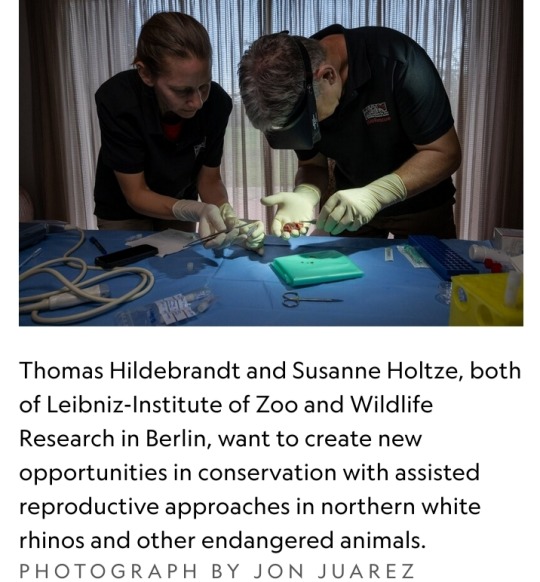
The next phase of BioRescue’s plan involves implanting one of their limited number of northern white rhino embryos into a southern white rhino surrogate mother — which the group plans to do within the next six months, Stejskal says.
They’ve identified the next surrogate mother and set up precautions to protect her from bacterial infections, including a new enclosure and protocols about disinfecting workers’ boots.
But now, they must wait until the female rhino is in estrus — the period when the animal is ready to mate — to implant the egg.
To identify that prime fertile time, they can’t readily perform regular ultrasounds at the conservancy as they might do in a zoo.
Instead, they have enlisted a rhino bull that has been sterilized to act as a “teaser” for the female, Hildebrandt says, adding that they must wait a few months to make sure that their recently sterilized male is truly free of residual sperm.
Once the animals are brought together, their couplings will alert conservancy staff that the timing is right for reproductive success.
The sex act is also important because it sets off an essential chain of events in the female’s body that boosts the chances of success when they surgically implant the embryo about a week later.
"There’s little chance the conservancy staff will miss the act. White rhinos typically mate for 90 minutes," Hildebrandt says.
What’s more, while mounted on the females, the males often use their temporary height to reach tasty plant snacks that are generally out of reach.
Boosting genetic diversity

With so few northern white rhinos left, their genetic viability may seem uncertain.
But the BioRescue team points to southern white rhinos, whose numbers likely dropped to less than 100, and perhaps even as few as 20, due to hunting in the late 1800s.
Government protections and intense conservation strategies allowed them to bounce back, and now there are almost 17,000.
“They have sufficient diversity to cope with a wide range of conditions,” says Balfour.
Researchers don’t know exactly how many southern white rhinos existed a century ago, he says, but it’s clear that the animals came back from an incredibly low population count and that they now appear healthy.
Beyond their small collection of embryos, the BioRescue team hopes to expand the northern white rhino’s gene pool by drawing from an unconventional source — skin cells extracted from preserved tissue samples that are currently stored at zoos.
They aim to use stem cell techniques to reengineer those cells and develop them into sex cells, building off similar work in lab mice.
According to their plan, those lab-engineered sex cells would then be combined with natural sperm and eggs to make embryos, and from there, the embryos would be implanted into southern white rhino surrogate mothers.
Such stem cell reprogramming work has previously led to healthy offspring in lab mice, Hildebrandt says, but rhinos aren’t as well-studied and understood as mice, making this work significantly challenging.
A global effort
The northern white rhino revitalization venture has cost millions of dollars, supported by a range of public and private donors, including the German Federal Ministry of Education and Research.
Other partners on the effort include the Leibniz Institute for Zoo and Wildlife Research, the Czech Republic’s Safari Park, Kenya Wildlife Service, Ol Pejeta Conservancy, and also Katsuhiko Hayashi, a professor of genome biology at Osaka University in Japan who conducted the mouse stem cell research.
Building upon Hayashi’s stem cell techniques could ultimately bring the northern white rhino gene pool up to 12 animals — including eggs from eight females and the semen of four bulls, according to Stejskal.
An alternative approach to making more babies, like crossbreeding northern and southern white rhinos, would mean the resulting calves wouldn’t be genetically pure northern white rhinos, Hildebrandt notes.
The two subspecies look quite similar, but the northern version has subtle physical differences, including hairier ears and feet that are better suited to its swampy habitat.
The two animals also have different genes that may provide disease resiliency or other benefits, Hildebrandt says.
There are unknown potential differences in behavior and ecological impact when populating the area with southern white rhinos or cross-bred animals.
"The northern white rhino is on the brink of extinction really only due to human greed,” Stejskal says.
“We are in a situation where saving them is at our fingertips, so I think we have a responsibility to try.”
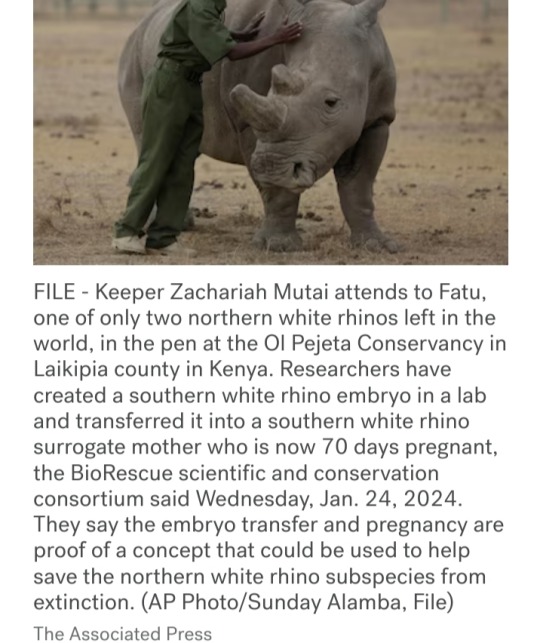
🩶🦏🩶
#northern white rhinoceros#rhino embryo transfer#in vitro fertilization#IVF#southern white rhinoceros#critically endangered animals#National Geographic#BioRescue#rhino horn#International Union for the Conservation of Nature#African rhino specialist group#Thomas Hildebrandt#German Federal Ministry of Education and Research#Leibniz Institute for Zoo and Wildlife Research#Kenya Wildlife Service#Ol Pejeta Conservancy#Katsuhiko Hayashi#genome biology#IVF rhino pregnancy
10 notes
·
View notes
Note
Stede this is important what are your opinions on this little guy? (Cryptochloris wintoni, or De Winton's golden mole, recently found again after being feared extinct for over 80 years!! 🎉)

Oh my gosh, what a lovely little fella! Moles are fascinating creatures and this one is particularly adorable. I'm glad they're still around! Moles have an incredibly sensitive sense of touch, and the star-nosed mole's snout is 6 times as sensitive as human hands!
#ooc: source: national wildlife federation's article on moles#ooc: I don't know mole facts but stede definitely does lol#ofmd#ask stede bonnet#our flag means death
9 notes
·
View notes
Text
keeping honeybee hives as a way to ‘save the bees’ is the equivalent of claiming factory farmed chickens are somehow stopping greater prairie chickens from going extinct lmao
#wanna know one of the worst takes I've seen by beekeepers lobbying the government?#putting honeybee hives in national parks#to help bee populations#anyway no offense to beekeepers out there who do what they do as a small business etc etc#but the beekeeping industry actively works to shift focus away from wild pollinator conservation onto honeybees#they have a lot of weight and money to throw around and they use it to influence federal and state policy#the relationship between native pollinator biologists and beekeepers is like that of wildlife biologists and hunters#we should be working together to address common issues that affect all these species. and occasionally we do. some of us are both#but way more frequently than necessary we have to walk on eggshells around you because if we upset you you'll rain hell upon us#i speak from experience as both a pollinator ecologist and a wildlife biologist and lemme tell you it's a drag#as long as you have government subsidy on your side you're invincible#remember kids we only rely on honeybees for so much pollination because we destroyed the habitat of native pollinators on farmland#despite this native pollinators account for a not insignificant portion of pollination but it's not widely publicized#it's estimated that if we provide native habitat free from pesticides then we can reduce reliance on honeybees significantly#enough that for some crops we wouldn't need them at all#galaxy brained athena take here: the next big thing will be 'wild pollinator certified' foods
10 notes
·
View notes
Photo
You can be someone else






Brave local and Federal Law Enforcement officers secure the road to the Malheur National Wildlife Refuge center currently under siege by radical extremists in Oregon.
#malheur national wildlife refuge#malheur wildlife refuge#burns#oregon#Oregon State Police#FBI#federal bureau of investigation#sheriff#trooper#police#law enforcement#cops#special agent#federal agent#feds#swat#special operations#spec ops#Hostage Rescue Team#HRT#ammon bundy#robert lavoy finicum#rifle#guns#firearms#tactical#sovereign citizen#three percenter#iii percenter#crime
825 notes
·
View notes
Link
In the article "Flying in Alaska — The Last Frontier," Will Dabbs, MD recounts his experiences during his military service in Alaska. Despite his initial desire to be stationed in Europe, Uncle Sam sent him to Alaska, a place vastly different from his humid upbringing in the Deep South. Dabbs describes the unique and challenging conditions of Alaska, from the intense cold to the stunning natural beauty. As an operations officer and later an aviation liaison officer, he flew CH-47D Chinook helicopters across the state, participating in numerous missions, including high-altitude rescues and resupply operations. He shares vivid memories of the rugged wilderness, abundant wildlife, and the camaraderie of military life. Through these experiences, Dabbs developed a deep appreciation for Alaska, despite the hardships of service and the extreme environment.
#Alaska#The Last Frontier#flying in Alaska#bush pilots#aviation challenges#remote areas#weather conditions#small aircraft#pilot training#survival skills#Federal Aviation Administration (FAA)#Denali National Park#aviation safety#emergency procedures#aircraft maintenance#floatplanes#ski-equipped planes#wildlife viewing#flightseeing tours#Alaskan wilderness#aviation culture#aviation history in Alaska.
0 notes
Text
Exploring Kuching Malaysia
Darul Hana Bridge and Sarawak Parliament Building Kuching is one of the most exotic and beautiful places I’ve visited in my travels. The tropical weather requires considerable adjustment for those unaccustomed to heat and humidity, and a daily swim in the lap pool helps! Kuching Apt Lap Pool Daytrips I’ve been exploring the surrounding areas but have had difficulty booking daytrips. There aren’t…

View On WordPress
#African National Congress (ANC)#Borneo Longhouses#Cape Town South Africa#Cape Whale Coast#Darul Hana Bridge Kuching#Democratic Alliance (DA)#East and West Malaysia#East Versus Peninsular Malaysia#Gabugan Parti Sarawak (GPS)#India Floating Mosque Kuching Waterfront#Irrawaddy (Snubfin) Dolphin#James Brooke Bistro Café Kuching#James Brooke Rajah of Sarawak#Kalimantan Indonesia#Malaysia Administrative Capital Putrajaya#Malaysian Federation#Malaysian State of Sarawak#Penang Malaysia#Peninsular Malaysia#Rainforest World Music Festival#Santubong River#Sarawak Cultural Village#Sarawak Parliament Building#Sarawak River Kuching#Sarawak Semenggoh Wildlife Centre#Sir James Brooke English Adventurer and Military Officer of the East India Company#South China Sea#State of Sabah#State of Sarawak#Sultanate of Brunei
1 note
·
View note
Text
Some good things happening at the local level: Land Back edition
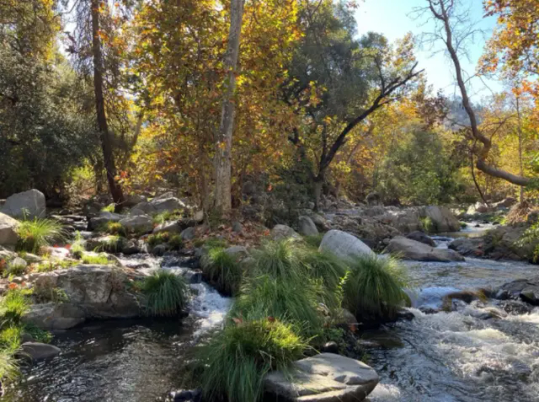
The Confederated Tribes of Siletz Indians purchased back 2,000 acres of deeply historically significant land in Oregon, the site of both a massacre of Native people at the hands of the US army, and the site of a treaty signing that established a temporary truce and reservation. (Posted Jan 21, 2025)
The property was purchased directly from the previous landowner. The Nature Conservancy preserves a conservation easement on the land. The Siletz will continue to work closely with the Nature Conservancy and the BLM across the properties in the region to emphasize conservation and restoration. “To me, land back means, in its purest form, its return of lands to a tribe,” Kentta [citizen of the Confederated Tribes of Siletz Indians and the tribal council treasurer] said. “This is through purchase, and a significant amount paid out for the purchase. So for us, that is regaining of land back, but it's not a settlement or apology for things that happened in the past.”
The Tule River Tribe in California is moving forward with a plan to buy back 14,673 acres of rivers, forests, ranchland, and wetland in a conservation project partnering with The Conservation Fund, the Wildlife Conservation Board, and various California conservation organizations. It's set to move into Tule River control (or at least co-management? unclear to me) sometime this year. (Posted January 8, updated January 10, 2025)
Charmaine McDarment, chairwoman of the Tule River Tribal Council, said in a press release that the tribe appreciates help in restoring ancestral homelands. “As the climate crisis brings new pressures to address the effects of environmental mismanagement and resource degradation, the Tribe’s partnership with WCB is an important example of building relationships based in collaboration and trust. “The tribe remains committed to supporting co-stewardship efforts and fighting to ensure that disproportionate harms to Native American lands, culture, and resources are resolved in a manner that centers and honors Native American connections to ancestral lands.”
Illinois lawmakers voted to move Shabbona Lake State Park to the management of The Prairie Band Potawatomi Nation. The Illinois governor has a lot on his plate right now, but is expected to sign the bill into law. (Posted January 14, 2025)
The state House approved SB 867, which would transfer Shabbona Lake State Park to the Prairie Band Potawatomi. The bill now heads to Illinois Gov. JB Pritzker for his signature. The land transfer hinges on an agreement that the tribe continue to operate the property as a park, still open to the public. Final details will be established in a forthcoming land management agreement between the state and tribe. Prairie Band Potawatomi Chairman Joseph “Zeke” Rupnick said the bill’s passage was a “meaningful step” toward righting a historic old wrong. The land was originally part of the tribe's 1,280-acre reservation in northern Illinois. During Chief Shab-eh-nay's visit to family in Kansas, the land was unlawfully auctioned off, violating federal requirements for Congressional approval of tribal land sales. The tribe has sought to reclaim the land for nearly two centuries.
A Wabanaki food sovereignty group secured a no-strings-attached land deal to buy 245 acres of farm and forest in Maine, to focus on local, traditional, and sustainable foods. (Posted January 19, 2025)
What sets this purchase apart is that the land transfer comes without conservation easements. These easements, which frequently accompany land returns or transfers, are often well-meaning. However, they can inhibit Indigenous stewardship by preventing practices such as prescribed burning, subdivision, or particular kinds of zoning for buildings or infrastructure. A coalition of 12 organizations and several private donors helped secure the land for Niweskok [a nonprofit collective of Wabanaki farmers, health professionals, and educators] without easements, giving the Wabanaki nonprofit sovereignty over the property, according to Heather Rogers, Land Protection Program director for Coastal Mountain Land Trust. Her organization has helped finance the Goose River purchase through fundraising and advocacy efforts. “The land trusts had to approach it with humility - there are other ways to care for land that can end up with better outcomes, and I think we have all come to that realization,” Rogers said. “I think now that we've done it once, I think we would be open to doing it again that way.”
Conservation, food sovereignty, water management - a few hundred acres here, a thousand acres there, there is movement to put lands back in tribal control, which is a human rights win as well as an ecology/conservation one. This is mostly happening at state and even private levels, and is something to continue advocating for, pushing for, donating to, and finding out if you have any local movements advocating for this kind of thing near you and calling state-level lawmakers and representatives about.
1K notes
·
View notes
Text
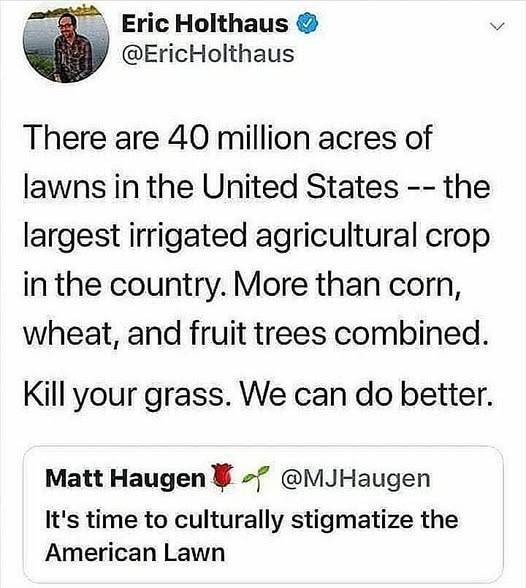
1K notes
·
View notes